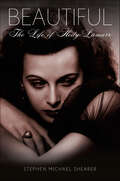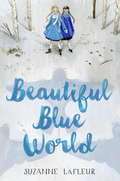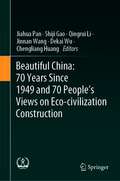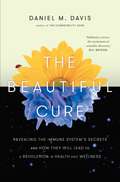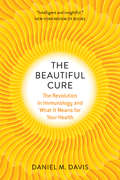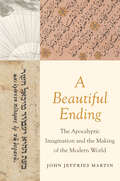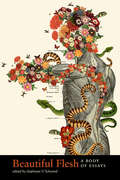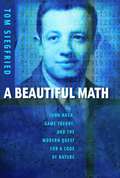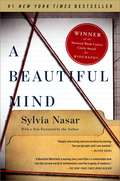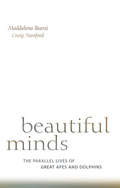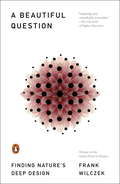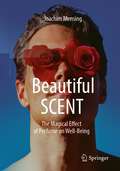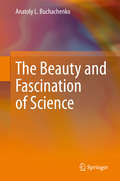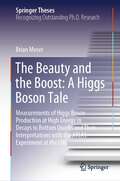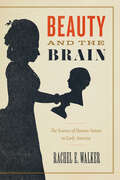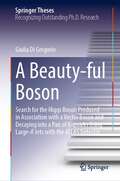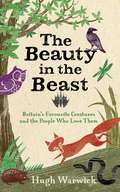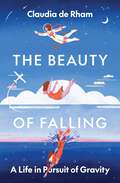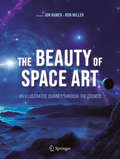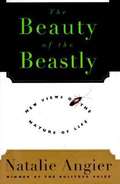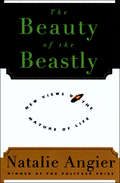- Table View
- List View
Beautiful: The Life of Hedy Lamarr
by Stephen Michael Shearer“A fascinating biography that re-creates Hollywood’s Golden Age of Glamour” as it recounts the life of the star and inventor (Publishers Weekly).Hedy Lamarr’s exotic beauty was heralded across Europe in the early 1930s. Yet she became infamous for her nude scenes in the scandalous movie Ecstasy. Trapped in a marriage to one of Austria’s munitions barons, a friend of Mussolini’s who hid his Jewish heritage to become an “honorary Aryan” at the onset of World War II, Lamarr fled Europe for Hollywood, where she was transformed into one of cinema’s most glamorous stars, appearing opposite such actors as Clark Gable, Spencer Tracy, and James Stewart. As her career faded, she went from one husband to the next, her personal troubles and legal woes casting a shadow over her phenomenal intelligence and former image.Stephen Michael Shearer separates the truth from the rumors regarding the life of Hedy Lamarr, and highlights her astonishing role as inventor of a technology that has become an essential part of everything from military weaponry to today’s cell phones.Praise for Beautiful“In Beautiful, Mr. Shearer writes with humor and has fun with some of the glorious nonsense of Lamarr’s movies.” —Jeanine Basinger, The Wall Street Journal“Much more than a standard Hollywood biography.” —Edge Magazine
Beautiful Blue World
by Suzanne LafleurBeautiful Blue World is a thrilling and moving story of children who become the key to winning a war. Sofarende is at war. For twelve-year-old Mathilde, it means food shortages, feuding neighbors, and bombings. Even so, as long as she and her best friend, Megs, are together, they’ll be all right. But the army is recruiting children, and paying families well for their service. If Megs takes the test, Mathilde knows she will pass. Megs hopes the army is the way to save her family. Mathilde fears it might separate them forever. This touching and suspenseful novel is a brilliant reimagining of war, where even kindness can be a weapon, and children have the power to see what adults cannot.From the Hardcover edition.
Beautiful Blue World
by Suzanne LafleurBeautiful Blue World is a thrilling and moving story of children who become the key to winning a war. Sofarende is at war. For twelve-year-old Mathilde, it means food shortages, feuding neighbors, and bombings. Even so, as long as she and her best friend, Megs, are together, they'll be all right. But the army is recruiting children, and paying families well for their service. If Megs takes the test, Mathilde knows she will pass. Megs hopes the army is the way to save her family. Mathilde fears it might separate them forever. This touching and suspenseful novel is a brilliant reimagining of war, where even kindness can be a weapon, and children have the power to see what adults cannot.From the Hardcover edition.
Beautiful China: 70 Years Since 1949 and 70 People’s Views on Eco-civilization Construction
by Jiahua Pan Shiji Gao Qingrui Li Jinnan Wang Dekai Wu Chengliang HuangThis book discusses and studies the basic course of ecological civilization construction in the 70 years since the founding of the People’s Republic of China and summarizes the experience and lessons. It contains 75 articles from 75 top experts and government officials in the field of ecological civilization policy-making and basic theory research in China, including Xi Jinping Thought on Ecological Civilization, ecological culture, green industry economy, environmental quality, legal system, ecological security and so on, so as to provide reference for understanding and studying the progress of ecological environment protection since the founding of China.
The Beautiful Cure: Revealing the Immune System's Secrets and How They Will Lead to a Revolution in Health and Wellness
by Daniel M. DavisA leading expert explains how discoveries about the immune system are leading the way to a revolution in beating cancer and other diseases.The immune system holds the key to human health. The scientific quest to understand how it works--and how it is affected by stress, diet, sleep, age, exercise and our state of mind--is now unlocking a revolutionary new approach to medicine and well-being. The body's ability to fight disease and heal itself is one of the great mysteries and marvels of nature, but within the last few years, painstaking research has resulted in major advances in our understanding of the immune system, revealing an inner world of breathtaking sophistication, complexity and beauty. Far more powerful than any medicine ever invented, it also plays a crucial role in our daily lives. Already we have found ways to harness these natural defences to create break-through drugs and therapies that can beat cancer, diabetes, arthritis and many age-related diseases, and we are starting to understand how activities such as mindfulness might play a role in enhancing our physical resilience. Written by an expert at the forefront of this adventure, The Beautiful Cure tells a dramatic story of detective work and discovery, of puzzles solved and of the mysteries that remain, of lives sacrificed and saved, introducing the reader to this revelatory new understanding of the human body and what it takes to be healthy.
The Beautiful Cure: The Revolution in Immunology and What It Means for Your Health
by Daniel M. Davis&“A terrific book by a consummate storyteller and scientific expert considers the past and future of the body&’s ability to fight disease and heal itself.&” —Adam Rutherford, The Guardian The immune system holds the key to human health. In The Beautiful Cure, leading immunologist Daniel M. Davis describes how the scientific quest to understand how the immune system works—and how it is affected by stress, sleep, age, and our state of mind—is now unlocking a revolutionary new approach to medicine and well-being. The body&’s ability to fight disease and heal itself is one of the great mysteries and marvels of nature. But in recent years, painstaking research has resulted in major advances in our grasp of this breathtakingly beautiful inner world: a vast and intricate network of specialist cells, regulatory proteins, and dedicated genes that are continually protecting our bodies. Far more powerful than any medicine ever invented, the immune system plays a crucial role in our daily lives. We have found ways to harness these natural defenses to create breakthrough drugs and so-called immunotherapies that help us fight cancer, diabetes, arthritis, and many age-related diseases, and we are starting to understand whether activities such as mindfulness might play a role in enhancing our physical resilience. Written by a researcher at the forefront of this adventure, The Beautiful Cure tells a dramatic story of scientific detective work and discovery, of puzzles solved and mysteries that linger, of lives sacrificed and saved. With expertise and eloquence, Davis introduces us to this revelatory new understanding of the human body and what it takes to be healthy. &“Visceral.&” —The Wall Street Journal &“Illuminating.&” —Publishers Weekly &“Heroic.&” —Science
A Beautiful Ending: The Apocalyptic Imagination and the Making of the Modern World
by John Jeffries MartinAn award-winning historian&’s revisionary account of the early modern world, showing how apocalyptic ideas stimulated political, religious, and intellectual transformations &“A masterful synthesis of the prognostications of faith, knowledge, and politics on a global stage. Martin&’s book illuminates one of the enduring themes that shaped the medieval and early modern world.&”—Paula E. Findlen, Stanford University In this revelatory immersion into the apocalyptic, messianic, and millenarian ideas and movements that created the modern world, John Jeffries Martin performs a kind of empathic time travel, entering into the psyche, spirituality, and temporalities of a cast of historical actors in profound moments of discovery. He argues that religious faith—Christian, Jewish, and Muslim—did not oppose but rather fostered the making of a modern scientific spirit, buoyed along by a providential view of history and nature, and a deep conviction in the coming End of the World. Through thoughtful attention to the primary sources, Martin re‑reads the Renaissance, excavating a religious foundation at the core of even the most radical empirical thinking. Familiar icons like Ibn Khaldūn, Columbus, Isaac Luria, and Francis Bacon emerge startlingly fresh and newly gleaned, agents of a history formerly untold and of a modern world made in the image of its imminent end.
Beautiful Flesh: A Body of Essays
by Stephanie G’SchwindSelected from the country’s leading literary journals and publications—Colorado Review, Creative Nonfiction, Georgia Review, Prairie Schooner, Crazyhorse, The Normal School, and others—Beautiful Flesh gathers eighteen essays on the body, essentially building a multi-gender, multi-ethnic body out of essays, each concerning a different part of the body: belly, brain, bones, blood, ears, eyes, hair, hands, heart, lungs, nose, ovaries, pancreas, sinuses, skin, spine, teeth, and vas deferens. The title is drawn from Wendy Call’s essay “Beautiful Flesh,” a meditation on the pancreas: “gorgeously ugly, hideously beautiful: crimson globes embedded in a pinkish-tan oval, all nestled on a bed of cabbage-olive green, spun through with gossamer gold.” Other essays include Dinty W. Moore’s “The Aquatic Ape,” in which the author explores the curious design and necessity of sinuses; Katherine E. Standefer’s “Shock to the Heart, Or: A Primer on the Practical Applications of Electricity,” a modular essay about the author’s internal cardiac defibrillator and the nature of electricity; Matt Roberts’s “Vasectomy Instruction 7,” in which the author considers the various reasons for and implications of surgically severing and sealing the vas deferens; and Peggy Shinner’s “Elective,” which examines the author’s own experience with rhinoplasty and cultural considerations of the “Jewish nose.” Echoing the myriad shapes, sizes, abilities, and types of the human body, these essays showcase the many forms of the genre: personal, memoir, lyric, braided, and so on. Contributors: Amy Butcher, Wendy Call, Steven Church, Sarah Rose Etter, Matthew Ferrence, Hester Kaplan, Sarah K. Lenz, Lupe Linares, Jody Mace, Dinty W. Moore, Angela Pelster, Matt Roberts, Peggy Shinner, Samantha Simpson, Floyd Skloot, Danielle R. Spencer, Katherine E. Standefer, Kaitlyn Teer, Sarah Viren, Vicki Weiqi Yang
A Beautiful Math
by Tom SiegfriedMillions have seen the movie and thousands have read the book but few have fully appreciated the mathematics developed by John Nash's beautiful mind. Today Nash's beautiful math has become a universal language for research in the social sciences and has infiltrated the realms of evolutionary biology, neuroscience, and even quantum physics. John Nash won the 1994 Nobel Prize in economics for pioneering research published in the 1950s on a new branch of mathematics known as game theory. At the time of Nash's early work, game theory was briefly popular among some mathematicians and Cold War analysts. But it remained obscure until the 1970s when evolutionary biologists began applying it to their work. In the 1980s economists began to embrace game theory. Since then it has found an ever expanding repertoire of applications among a wide range of scientific disciplines. Today neuroscientists peer into game players' brains, anthropologists play games with people from primitive cultures, biologists use games to explain the evolution of human language, and mathematicians exploit games to better understand social networks. A common thread connecting much of this research is its relevance to the ancient quest for a science of human social behavior, or a Code of Nature, in the spirit of the fictional science of psychohistory described in the famous Foundation novels by the late Isaac Asimov. In A Beautiful Math, acclaimed science writer Tom Siegfried describes how game theory links the life sciences, social sciences, and physical sciences in a way that may bring Asimov's dream closer to reality.
A Beautiful Mind (Shooting Script Ser.)
by Sylvia Nasar**Also an Academy Award–winning film starring Russell Crowe and Jennifer Connelly—directed by Ron Howard** The powerful, dramatic biography of math genius John Nash, who overcame serious mental illness and schizophrenia to win the Nobel Prize.“How could you, a mathematician, believe that extraterrestrials were sending you messages?” the visitor from Harvard asked the West Virginian with the movie-star looks and Olympian manner. “Because the ideas I had about supernatural beings came to me the same way my mathematical ideas did,” came the answer. “So I took them seriously.” Thus begins the true story of John Nash, the mathematical genius who was a legend by age thirty when he slipped into madness, and who—thanks to the selflessness of a beautiful woman and the loyalty of the mathematics community—emerged after decades of ghostlike existence to win a Nobel Prize for triggering the game theory revolution. The inspiration for an Academy Award–winning movie, Sylvia Nasar’s now-classic biography is a drama about the mystery of the human mind, triumph over adversity, and the healing power of love.
Beautiful Minds: The Parallel Lives of Great Apes and Dolphins
by Maddalena Bearzi Craig B StanfordApes and dolphins: primates and cetaceans. Could any creatures appear to be more different? Yet both are large-brained intelligent mammals with complex communication and social interaction. In the first book to study apes and dolphins side by side, Maddalena Bearzi and Craig B. Stanford, a dolphin biologist and a primatologist who have spent their careers studying these animals in the wild, combine their insights with compelling results. Beautiful Minds explains how and why apes and dolphins are so distantly related yet so cognitively alike and what this teaches us about another large-brained mammal: Homo sapiens. Noting that apes and dolphins have had no common ancestor in nearly 100 million years, Bearzi and Stanford describe the parallel evolution that gave rise to their intelligence. And they closely observe that intelligence in action, in the territorial grassland and rainforest communities of chimpanzees and other apes, and in groups of dolphins moving freely through open coastal waters. The authors detail their subjects’ ability to develop family bonds, form alliances, and care for their young. They offer an understanding of their culture, politics, social structure, personality, and capacity for emotion. The resulting dual portrait—with striking overlaps in behavior—is key to understanding the nature of “beautiful minds.”
A Beautiful Question: Finding Nature's Deep Design
by Frank WilczekDoes the universe embody beautiful ideas?Artists as well as scientists throughout human history have pondered this "beautiful question." With Nobel laureate Frank Wilczek as your guide, embark on a voyage of related discoveries, from Plato and Pythagoras up to the present. Wilczek's groundbreaking work in quantum physics was inspired by his intuition to look for a deeper order of beauty in nature. In fact, every major advance in his career came from this intuition: to assume that the universe embodies beautiful forms, forms whose hallmarks are symmetry--harmony, balance, proportion--and economy. There are other meanings of "beauty," but this is the deep logic of the universe--and it is no accident that it is also at the heart of what we find aesthetically pleasing and inspiring.Wilczek is hardly alone among great scientists in charting his course using beauty as his compass. As he reveals in A Beautiful Question, this has been the heart of scientific pursuit from Pythagoras, the ancient Greek who was the first to argue that "all things are number," to Galileo, Newton, Maxwell, Einstein, and into the deep waters of twentiethcentury physics. Though the ancients weren't right about everything, their ardent belief in the music of the spheres has proved true down to the quantum level. Indeed, Wilczek explores just how intertwined our ideas about beauty and art are with our scientific understanding of the cosmos.Wilczek brings us right to the edge of knowledge today, where the core insights of even the craziest quantum ideas apply principles we all understand. The equations for atoms and light are almost literally the same equations that govern musical instruments and sound; the subatomic particles that are responsible for most of our mass are determined by simple geometric symmetries. The universe itself, suggests Wilczek, seems to want to embody beautiful and elegant forms. Perhaps this force is the pure elegance of numbers, perhaps the work of a higher being, or somewhere between. Either way, we don't depart from the infinite and infinitesimal after all; we're profoundly connected to them, and we connect them. When we find that our sense of beauty is realized in the physical world, we are discovering something about the world, but also something about ourselves.Gorgeously illustrated, A Beautiful Question is a mind-shifting book that braids the age-old quest for beauty and the age-old quest for truth into a thrilling synthesis. It is a dazzling and important work from one of our best thinkers, whose humor and infectious sense of wonder animate every page. Yes: The world is a work of art, and its deepest truths are ones we already feel, as if they were somehow written in our souls.
Beautiful SCENT: The Magical Effect of Perfume on Well-Being
by Joachim MensingThis book will make you a perfume insider. Discover the effects, trends and future of perfume. Perfumery is on the verge of its third revolution, neuroperfumery, due to new methods of brain research and current findings in fragrance psychology.With this exciting and well-written book, you will gain a comprehensive insight into the creation, world and practice of modern perfumery, as well as interesting insider information. Current findings in psychology, aromatherapy, brain research and neuroperfumery on the effects of fragrances make Beautiful SCENT a treasure trove of new insights. As a non-fiction book with an advice component, it is easy to read without prior knowledge and provides many practical tips. Among other things, you will learn that some perfumes can do much more than just smell good, how perfumers and marketers create their perfumes, which scent preferences prevail and how the effect of scent can specifically influence one's own experience and enjoyment of life. Target groupsAll those who love perfumes and fragrances and would like to learn more about the magical effect of perfumes on well-being and perhaps play with the idea of creating their own perfume one day. It is also ideal for those who work in the fragrance, cosmetics and beauty industry and would like to refresh their knowledge of perfumes. About the authorDr. Joachim Mensing is a qualified psychologist, sociologist and trained nose with over 30 years of professional experience in perfumery and fragrance therapy. At one of the largest fragrance manufacturers, he became a trend coach for perfumers and developed methods of perfume development and marketing. Many of the perfumes he worked on received coveted awards such as the Fifi Award, the Oscar for perfumes. He himself received the honorary award of the FRAGRANCE FOUNDATION for the development and marketing of the perfumes Cool Water by Davidoff, Joop! and Jil Sander, and he was also recognized for studies in neuroperfumery and neuropsychology.
The Beauty and Fascination of Science
by Anatoly L. BuchachenkoIn this book, Professor Anatoly Buchachenko gives a brief and informative description of the most striking achievements and discoveries made in the major natural sciences at the turn of the century – in the late twentieth and early twenty-first centuries. The author has a rare ability to describe scientific discoveries so that these achievements and their significance are understandable not only by professionals and scientists of all specialities, but for any reader interested in modern science, its role in the existence of mankind, and its impact on human society. Originally published in Russian, Professor Buchachenko’s book describes the interaction of natural sciences with social ones—philosophy and history—as well as the part played by the human factor in the development of science, especially the role of the great scientists.
The Beauty and the Boost: Measurements of Higgs Boson Production at High Energy in Decays to Bottom Quarks and Their Interpretations with the ATLAS Experiment at the LHC (Springer Theses)
by Brian MoserPrecision measurements of the Higgs boson’s properties are a powerful tool to look for deviations from the predictions of the Standard Model (SM) of particle physics. The 139/fb of proton-proton collision data which have been collected by the ATLAS experiment during Run 2 of the LHC, offer an opportunity to investigate rare Higgs-boson topologies, which are particularly sensitive to new physics scenarios but experimentally difficult to access. Several such measurements, which target Higgs-boson decays to heavy-flavour quarks, as well as their combinations are presented in this thesis. A novel analysis that measures Higgs-boson production in association with a heavy vector boson V (VH, with V=W,Z) at high energies is presented. Dedicated Higgs-boson reconstruction techniques are applied to reconstruct the highly Lorentz-boosted Higgs-boson decays into pairs of bottom quarks. The measurement is subsequently combined with a VH cross-section measurement at low and intermediate pT(V) to provide a differential cross-section measurement in kinematic fiducial volumes over the largest possible pT(V) range. All cross-section measurements agree with the SM predictions within relative uncertainties that range from 30% to 300%. The results are furthermore interpreted as limits on the parameters of a SM effective field theory. Finally, a combination of measurements of Higgs decays to heavy-flavour quarks is used to experimentally determine that the Higgs-boson coupling to charm quarks is weaker than to bottom quarks, as predicted by the SM. The target audience for the thesis are physicists and physics students, in particular those with a background in high energy physics.
Beauty and the Brain: The Science of Human Nature in Early America
by Rachel E. WalkerExamining the history of phrenology and physiognomy, Beauty and the Brain proposes a bold new way of understanding the connection between science, politics, and popular culture in early America. Between the 1770s and the 1860s, people all across the globe relied on physiognomy and phrenology to evaluate human worth. These once-popular but now discredited disciplines were based on a deceptively simple premise: that facial features or skull shape could reveal a person’s intelligence, character, and personality. In the United States, these were culturally ubiquitous sciences that both elite thinkers and ordinary people used to understand human nature. While the modern world dismisses phrenology and physiognomy as silly and debunked disciplines, Beauty and the Brain shows why they must be taken seriously: they were the intellectual tools that a diverse group of Americans used to debate questions of race, gender, and social justice. While prominent intellectuals and political thinkers invoked these sciences to justify hierarchy, marginalized people and progressive activists deployed them for their own political aims, creatively interpreting human minds and bodies as they fought for racial justice and gender equality. Ultimately, though, physiognomy and phrenology were as dangerous as they were popular. In addition to validating the idea that external beauty was a sign of internal worth, these disciplines often appealed to the very people who were damaged by their prejudicial doctrines. In taking physiognomy and phrenology seriously, Beauty and the Brain recovers a vibrant—if largely forgotten—cultural and intellectual universe, showing how popular sciences shaped some of the greatest political debates of the American past.
Beauty and the Brain: The Science of Human Nature in Early America
by Rachel E. WalkerExamining the history of phrenology and physiognomy, Beauty and the Brain proposes a bold new way of understanding the connection between science, politics, and popular culture in early America. Between the 1770s and the 1860s, people all across the globe relied on physiognomy and phrenology to evaluate human worth. These once-popular but now discredited disciplines were based on a deceptively simple premise: that facial features or skull shape could reveal a person’s intelligence, character, and personality. In the United States, these were culturally ubiquitous sciences that both elite thinkers and ordinary people used to understand human nature. While the modern world dismisses phrenology and physiognomy as silly and debunked disciplines, Beauty and the Brain shows why they must be taken seriously: they were the intellectual tools that a diverse group of Americans used to debate questions of race, gender, and social justice. While prominent intellectuals and political thinkers invoked these sciences to justify hierarchy, marginalized people and progressive activists deployed them for their own political aims, creatively interpreting human minds and bodies as they fought for racial justice and gender equality. Ultimately, though, physiognomy and phrenology were as dangerous as they were popular. In addition to validating the idea that external beauty was a sign of internal worth, these disciplines often appealed to the very people who were damaged by their prejudicial doctrines. In taking physiognomy and phrenology seriously, Beauty and the Brain recovers a vibrant—if largely forgotten—cultural and intellectual universe, showing how popular sciences shaped some of the greatest political debates of the American past.
A Beauty-ful Boson: Search for the Higgs Boson Produced in Association with a Vector Boson and Decaying into a Pair of b-quarks Using Large-R Jets with the ATLAS Detector (Springer Theses)
by Giulia Di GregorioThe analysis described in this thesis is the search for the Higgs boson, decaying into bb pair, in the associated production with a vector boson, in the extreme Higgs boson transverse momentum region where the Higgs boson is reconstructed using the large-R jet technique. The use of the large-R jets allows to add a part of the phase space unexplored so far, which is particularly sensitive to possible new physics.The analysed data have been collected at LHC by the ATLAS detector between 2015 and 2018 at a centre-of-mass energy of √s = 13 TeV. The same dataset has been used to perform the differential pp → ZH and pp → WH cross-section measurements used to extract the information on the Higgs couplings and to put limits on Beyond the Standard Model effects.Furthermore the analysis has been re-used to perform a cross-section measurement of the diboson ZZ and WZ processes because the diboson and the Higgs processes have a similar topology. For the first time the ZZ(bb) and WZ(bb) cross-sections are measured at √s = 13 TeV and the observed cross-section measurements are consistent with the Standard Model predictions.
Beauty in Chemistry: Artistry in the Creation of New Molecules (Topics in Current Chemistry #323)
by Luigi FabbrizziThe Beauty of Chemistry in the Words of Writers and in the Hands of Scientists, by Margherita Venturi, Enrico Marchi und Vincenzo Balzani Living in a Cage Is a Restricted Privilege, by Luigi Fabbrizzi Inner and Outer Beauty, by Kenneth N. Raymond und Casey J. Brown The Mechanical Bond: A Work of Art, by Carson J. Bruns und J. Fraser Stoddart The Beauty of Knots at the Molecular Level, by Jean-Pierre Sauvage und David B. Amabilino
The Beauty in the Beast: Britain's Favourite Creatures and the People Who Love Them
by Hugh WarwickA delightful portrait of some of the UK's best-loved wild animals and birds and the colourful enthusiasts who champion their causes.
The Beauty of Chemistry: Art, Wonder, and Science
by Philip BallImages and text capture the astonishing beauty of the chemical processes that create snowflakes, bubbles, flames, and other wonders of nature.Chemistry is not just about microscopic atoms doing inscrutable things; it is the process that makes flowers and galaxies. We rely on it for bread-baking, vegetable-growing, and producing the materials of daily life. In stunning images and illuminating text, this book captures chemistry as it unfolds. Using such techniques as microphotography, time-lapse photography, and infrared thermal imaging, The Beauty of Chemistry shows us how chemistry underpins the formation of snowflakes, the science of champagne, the colors of flowers, and other wonders of nature and technology. We see the marvelous configurations of chemical gardens; the amazing transformations of evaporation, distillation, and precipitation; heat made visible; and more.
The Beauty of Falling: A Life in Pursuit of Gravity
by Claudia de RhamA world-renowned physicist seeks gravity&’s true nature and finds wisdom in embracing its force in her lifeClaudia de Rham has been playing with gravity her entire life. As a diver, experimenting with her body&’s buoyancy in the Indian Ocean. As a pilot, soaring over Canadian waterfalls on dark mornings before beginning her daily scientific research. As an astronaut candidate, dreaming of the experience of flying free from Earth&’s pull. And as a physicist, discovering new sides to gravity&’s irresistible personality by exploring the limits of Einstein&’s general theory of relativity. In The Beauty of Falling, de Rham shares captivating stories about her quest to gain intimacy with gravity, to understand both its feeling and fundamental nature. Her life&’s pursuit led her from a twist of fate that snatched away her dream of becoming an astronaut to an exhilarating breakthrough at the very frontiers of gravitational physics.While many of us presume to know gravity quite well, the brightest scientists in history have yet to fully answer the simple question: what exactly is gravity? De Rham reveals how great minds—from Newton and Einstein to Stephen Hawking, Andrea Ghez, and Roger Penrose—led her to the edge of knowledge about this fundamental force. She found hints of a hidden side to gravity at the particle level where Einstein&’s theory breaks down, leading her to develop a new theory of &“massive gravity.&” De Rham shares how her life&’s path turned from a precipitous fall to an exquisite flight toward the discovery of something entirely new about our surprising, gravity-driven universe.
The Beauty of Space Art: An Illustrated Journey Through the Cosmos
by Jon Ramer Ron MillerLong before humans wrote, we painted.From mud and ash to acrylic and computers, artists across the centuries have found countless inventive ways to explore and express some of life’s biggest mysteries. Enter space art, a genre of artistic expression that strives to capture the wonders of our universe. This lavishly illustrated book chronicles the remarkable development of space art from a fledgling theme to a modern movement.In Part I, we traverse the history of art and astronomy from ancient times, through the Industrial Revolution, and into the 20th-century Space Age. Part II delves into the diverse techniques and subgenres of space art, where you will learn about things like rocks and balls, hardware art, and cosmic expressionism. Along the way, we’ll stop at places where neither humans nor spacecraft can easily go, from the scorching surface of Venus and the radiation-soaked volcanoes of Io to the alien terrain of exoplanets and the depths of distant galaxies.Featuring hundreds of original color images from space artists and astronomers alike, this book is a vivid visual story about the power of art, astronomy, and human curiosity. A heavily revised edition of the original Beauty of Space, it will entertain, educate, and inspire anybody who yearns to make sense of the strange and surreal sights in our universe.
The Beauty of the Beastly: New Views on the Nature of Life
by Natalie AngierNatalie Angier, one of the foremost American science writers, is the author of the masterly book "Natural Obsessions: The Search for the Oncogene (1988)". Now, in "The Beauty of the Beastly", she has reshaped many of her daily and weekly articles into a narrative that vividly conveys the discoveries of contemporary biological science and how biologists made them. She has arranged her topics according to the energy from which they spring - the life forces that inform and energize her (and our) work. To Angier, the movement, the dance, the play of life supplies the heartbeat of knowledge. In seven sections entitled, in order: Loving, Dancing, Slithering, Adapting, Healing, Creating, and Dying; Angier focuses on what science knows about the living world, in her own witty and exalted language.
The Beauty Of The Beastly: New Views on the Nature of Life
by Natalie AngierNatalie Angier knows all that scientists know - and sometimes more - about the power of symmetry in sexual relations, about the brutal courting habits of dolphins, about the grand deceit of orchids, about the impact of female and male preferences on evolution. She knows how scientists go about their work, and she describes their ways, their visions, and their arguments. Perhaps most poignantly, she understands the complexities and the sad necessity of death. "The beauty of the natural world lies in the details, and most of those details are not the stuff of calendar art," she points out. Few writers have ever covered so many facets of biology so evocatively in one book. The Beauty of the Beastly tells us how the genius of the biological universe resides in its details and proves why, according to Timothy Ferris, author of the acclaimed Coming of Age in the Milky Way, Angier is "one of the strongest and wittiest science writers in the world today."
